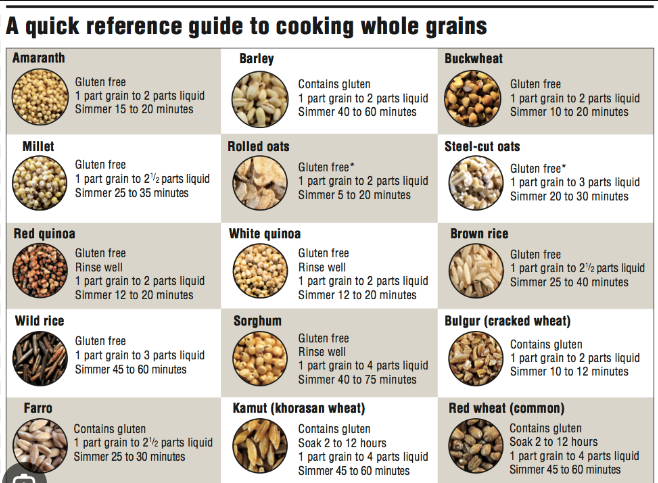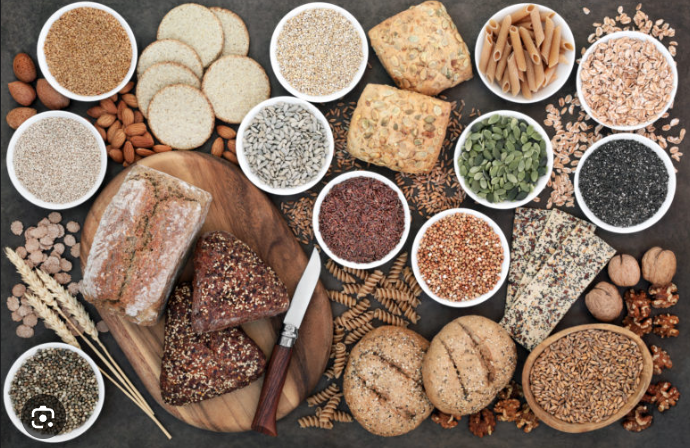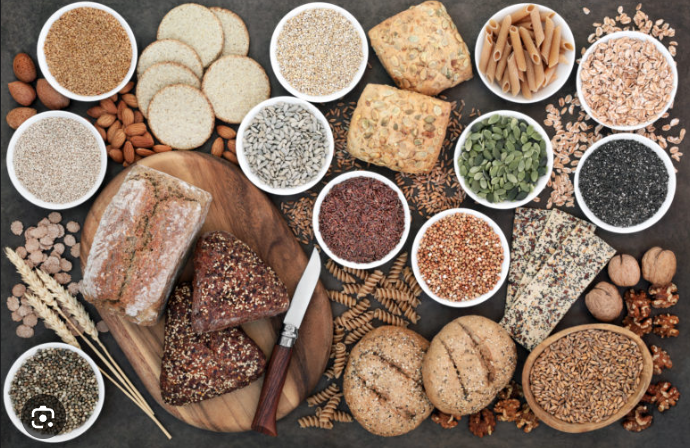The first whole grains that come to mind may be brown rice and quinoa, but there are others that can broaden your options. Explore these gluten-free, Nutritious whole-grain recipes that use lesser-known ancient grains that are both healthy and delicious.
“Whole grains at every meal” is the slogan from the Oldways Whole Grains Council. It’s a good reminder since most Americans fail to eat enough whole grains, averaging less than one daily serving. Some studies show that 40% of Americans never eat whole grains at all.

Also read-The Blood Type Diet: Does It Work? Information and Alternatives
Whole grains contain all three parts of the grain: the outer layer bran, the nutrient-rich germ, and the starchy endosperm. Whole grains provide important nutrients, and daily consumption is linked to a wide range of health benefits. By contrast, refined grains like white flour and white rice contain fewer nutrients and do not provide the same benefits as whole grains.
Benefits and Types of Whole Grains

According to the most recent World Health Organization recommendations, whole grains, vegetables, fruits, and pulses should make up the majority of your daily carbohydrate diet. These foods are high in fiber, which is associated with a 20% reduction in mortality from all causes as well as a lower risk of heart disease, stroke, and type 2 diabetes.
The numerous health advantages of whole grains may persuade you to increase your consumption. But the majority of people continue to consume whole grains.
Although eating a bowl of oatmeal in the morning, a sandwich on whole-wheat bread, and adding quinoa to grain bowls and salads are all healthy choices, there are a ton of other lesser-known whole grains that are equally nutritious.
It seems like quinoa is the food du jour right now. According to a nationwide consumer poll carried out by Denver-based flour-milling and ingredient company Ardent Mills, whole grains are perceived as having the best nutritional qualities. According to the survey, 86% of Americans are aware of quinoa, a complete grain high in protein but technically a seed.
Not as much love is shown to other whole grains. Here is a list of whole grains you should include on your grocery list, including some of the more unusual ancient grains.
List of Whole Grains
- Amaranth.
- Barley.
- Dark rice.
- Buckwheat.
- Farro.
- Fonio.
- Oats.
- Quinoa.
- Sorghum.
- Teff.
- Sonora blanca.
These lesser-known ancient grains can help you add variety to your meals while also providing unique flavor experiences and health advantages. Try the recipes below and look for new whole grains at your local grocery store.
Whole Grain vs. Whole Wheat

The terminology used to describe whole grains can occasionally be unclear. “Whole grain” simply means that the bran, or outer layer, the nutrient-rich germ, and the starchy endosperm have all been preserved. Any grain, including wheat, is included in this.
The phrase “whole wheat” refers to goods made from the entire wheat kernel, such as whole wheat bread, flour, or pasta. Wheat is included in the definition of whole grain because it is a type of grain. Contrast that, however, with “multigrain” or “wheat” bread.
The basic issue is that until you see the word “whole,” it is not whole wheat.
Are whole grains gluten-free?

Some whole grains don’t contain gluten, but others do. All varieties of wheat, including bulgur, wheat berries, spelt, farro, kamut, emmer, einkorn, couscous, and white sonora (although the amount of gluten in each of these grains varies), include gluten. Rye, barley, and triticale, a wheat-rye hybrid, are additional grains that contain gluten.
These whole grains are naturally gluten-free:
- Amaranth.
- Buckwheat.
- Fonio.
- Millet.
- Sorghum.
- Teff.
- Quinoa.
Oats are naturally gluten-free, yet they often come into contact with wheat and other gluten-containing grains during production. Oats labeled gluten-free have not been cross-contaminated.
Whole Grain and Gluten-Free Recipes

Try sorghum in this salad recipe from the United Sorghum Checkoff Program, courtesy of Sharon Palmer, The Plant-Powered Dietitian, as a place to start.
Spicy sorghum avocado salad
Ingredients:
- 3 cups cooked sorghum (according to package directions), cooled
- 1 ripe avocado, diced
- 1 cup cherry tomatoes, halved
- 1 cup corn.
- 3 diced green onions.
- ½ cup chopped cilantro
- 1 lemon, juiced
- 1 tablespoon extra-virgin olive oil
- 2 cloves garlic, minced
- ¼ jalapeno, finely diced.
- ¼ teaspoon smoked red paprika
Instructions:
- Mix together cooked sorghum, avocado, tomatoes, corn, onions, and cilantro in a medium bowl.
- In a small bowl, whisk together lemon, olive oil, garlic, jalapeno, paprika, and salt (optional).
- Pour the dressing over the sorghum mixture and toss gently to distribute.
- Serve at room temperature or chill until serving time.
Discover fonio with this porridge recipe from the Oldways Whole Grains Council, provided by Kelly LeBlanc, a registered dietitian and vice president of nutrition programming at Oldways. This is another whole-grain food option.
Fonio porridge with peanut butter and caramelized bananas
Ingredients:
- ½ tablespoon coconut or canola oil
- 1 banana, sliced into rounds
- ½ cup fonio.
- 1 cup milk, divided (or nut milk).
- 1 tablespoon peanut butter
- 2 teaspoons honey.
- ½ teaspoon cinnamon.
Instructions:
- Heat a small skillet over medium-low heat. Melt coconut oil in the skillet, then fry banana slices for 2 to 3 minutes on each side. Turn off the heat and let banana slices stay warm on the skillet.
- In a small pot, bring fonio and ½ cup milk to a near boil, then reduce heat all the way to low and let sit until liquid is absorbed, about 3 minutes. Stir in the peanut butter, honey, and an additional ½ cup milk until porridge reaches the desired texture.
- Divide into 2 bowls and top with caramelized banana slices.
Also read-Blueberries’ Proven Health Advantages
Images source: Google




































